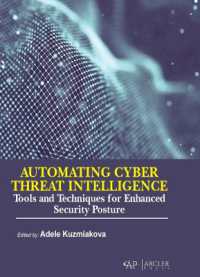- ホーム
- > 洋書
- > 英文書
- > Science / Mathematics
Full Description
The ability to detect and locate targets by day or night, over wide areas, regardless of weather conditions has long made radar a key sensor in many military and civil applications. However, the ability to automatically and reliably distinguish different targets represents a difficult challenge. Radar Automatic Target Recognition (ATR) and Non-Cooperative Target Recognition (NCTR) captures material presented in the NATO SET-172 lecture series to provide an overview of the state-of-the-art and continuing challenges of radar target recognition.
Topics covered include the problem as applied to the ground, air and maritime domains; the impact of image quality on the overall target recognition performance; the performance of different approaches to the classifier algorithm; the improvement in performance to be gained when a target can be viewed from more than one perspective; the impact of compressive sensing; advances in change detection; and challenges and directions for future research.
Radar Automatic Target Recognition (ATR) and Non-Cooperative Target Recognition (NCTR) explores both the fundamentals of classification techniques applied to data from a variety of radar modes and selected advanced techniques at the forefront of research, and is essential reading for academic, industrial and military radar researchers, students and engineers worldwide.
Contents
Chapter 1: Introduction
Chapter 2: Automatic target recognition of ground targets
Chapter 3: Automatic recognition of air targets
Chapter 4: Radar ATR of maritime targets
Chapter 5: Effects of image quality on target recognition
Chapter 6: Comparing classifier effectiveness
Chapter 7: Biologically inspired and multi-perspective target recognition
Chapter 8: Radar applications of compressive sensing
Chapter 9: Advances in SAR change detection
Chapter 10: Future challenges





